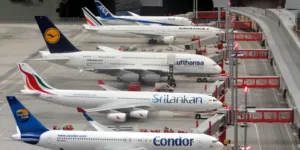Maintenance is crucial with any complex piece of machinery, but it’s exceptionally crucial when that large piece of complex equipment is going up into the sky. This is why aviation equipment is in constant need of inspection, and there are very high standards about how to do so. Add to the fact that the industry is booming and mechanics are expected to inspect and process equipment at a very high rate, and efficiency is no longer an option, it’s vital. That’s why airplane mechanics are heavily relying on borescope tools to process inspections and diagnose mechanical issues with equipment now more than ever.
Inspection and Maintenance Go Hand-In-Hand
There may be some routine parts of maintenance, like fluid changes, fueling up, and so on, but the biggest part of maintenance is repairing damages before they lead to major catastrophe. The problem that presents itself here is, you can’t always do a complete teardown to get your eyes on the problem, and there’s no magical machine you can hook an airplane up to for diagnosis of (most) problems. The most efficient way to get your eyes on a system is by using a borescope, hence their importance to the industry.
According to FAA Code of Federal Regulation, an Annual and 100-hour inspection must include the following inspection points:
Engine Compartment – The engine compartment must be inspected for any evidence of oil leaks, fuel leaks, or hydraulic leaks. If evidence is found, the source must be identified and repaired.
Studs and Nuts – Hardware has to be checked for improper torquing and signs of damage, any defective hardware has to be replaced.
Inside the Engine – Improper compression, evidence of metal particles, tolerances, and signs of damage have to be corrected.
Engine Mounts – Technicians are on the lookout for cracking and sagging mounts that will cause engine twist.
Exhaust – Attachment points are inspected for needed repairs or replacement.
Accessories and Small Parts – Nothing is overlooked, from fuel lines to hoses to clamps, and more, anything that shows wear is tossed and replaced.
Really, all systems are going to need to be examined during these particular inspections, but a majority of the parts are checked between flights to ensure the safety of the passengers, and people on the ground below. Daily and pre-flight inspections are when techs find themselves in a crunch having to check the landing gear, emergency exits, air inlet, empennage, cabin air stair door, fuel bays, nose gears, wings, and cargo door area in what boils down to minutes.
Inspection Tools
So we’ve determined that there’s two things that happen when aircraft maintenance and inspection are being performed, and that’s extreme thoroughness and not a lot of time to work with. Borescopes for aircraft use are made to be extremely durable, mobile, clear, and easy to use. They stand up to tough conditions and can get to the hardest to reach places on an aircraft.
As aviation technician turned author of general aviation maintenance books Mike Busch explains about his use of borescopes “By inserting the scope through the top spark plug hole and twisting and turning it, I could get a decent view of the intake and exhaust valves, the cylinder walls, and the piston crown. I found it spellbinding. Direct inspection of the combustion chamber provided a much better picture and deeper understanding of the true condition of the cylinder, compared with the crude, indirect assessment provided by the differential compression test. A compression test could tell you that air was leaking past the exhaust valve, but with the borescope you could tell whether it was because of a benign glob of lead on the seat that would quickly resolve itself the next time the engine ran—or a malignant, warped or eroded valve likely to fail catastrophically in the next 10 hours. How cool was that?”
It’s apparent when using borescopes in aviation applications that not all borescopes are created equal. The quality is, of course, a major factor. It also has to be the right tube length, and you’ll need a high-resolution LCD monitor to see what you’re looking at amongst thousands of moving parts on an airplane.
The bottom line: Aircrafts are complex, and there’s no room for error. Too much is at stake, too much could go wrong, and there’s never a good time for systems to malfunction on an aircraft.
About SPI Borescopes
We serve many different industries, including aviation engineering and maintenance. In order to meet the needs of our customers with the right tools, we have to keep up-to-date on all of the regulations and rules surrounding standards and inspections. By conducting studies like the one above, we are able to design products to meet these needs, and understand that aircraft mechanics also face the unique challenge of time constraints.








